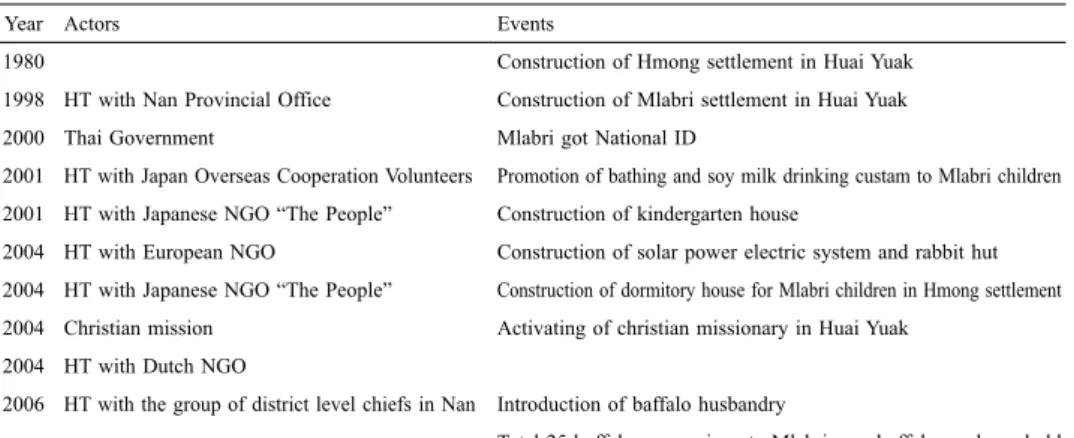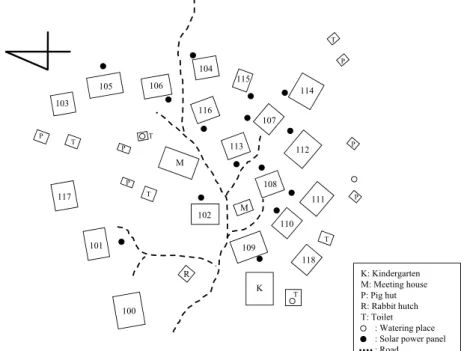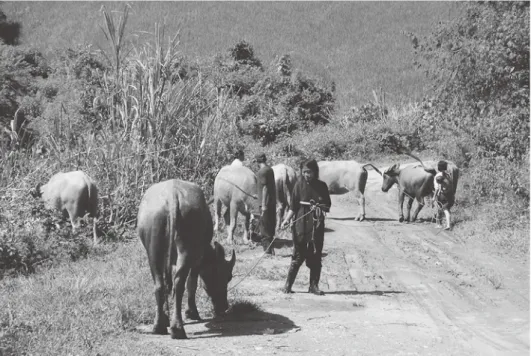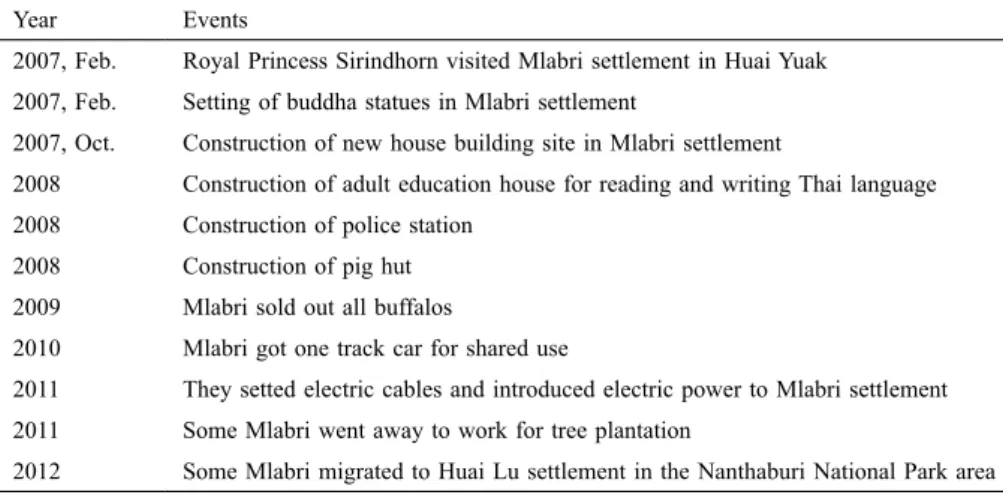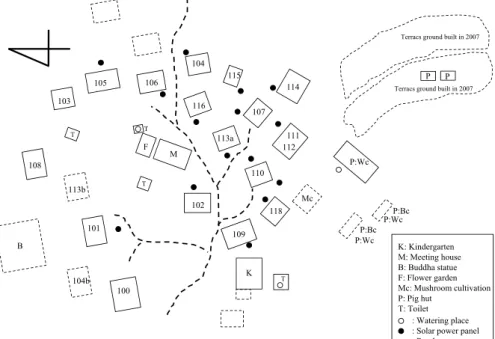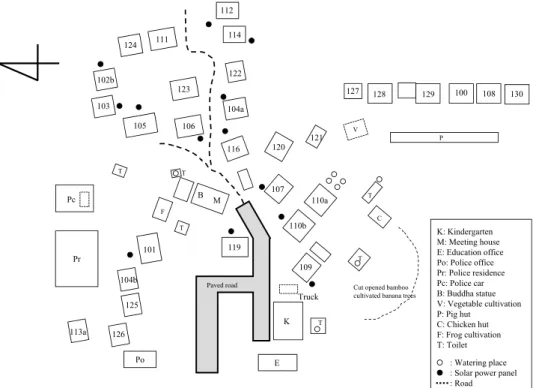year 2017‑11‑21
URL http://doi.org/10.15021/00008583
171 Kazunobu Ikeya
National Museum of Ethnology
Shinsuke Nakai
Saga University
ABSTRACT
The process of landscape change that the hunter-gatherer Mlabri community at HY village in Nan Province, Thailand, has experienced since the start of settlement in 1998 is described in this article by referring to the results of intermittent field research divided, and is into three periods: (1) pre-Royal Project period (1998-2007), (2) first Royal Project period (2007-2010), and (3) second Royal Project period (2010-2012). In summarizing these three periods, the following characteristics can be highlighted. First, regarding occupation, animal husbandry and plant cultivation have had difficulty in being accepted. Water buffalo, chickens, pigs, frogs, mushrooms, and vegetables have been tried, but failure has been frequent. Second, the community has been monitored constantly by the police since the Royal Project started. It is not a general situation of the villages in Thailand. Finally, the community’s development context is extremely complicated. The number of actors involved, such as in the Royal Project, have been increasing, especially since 2007.
INTRODUCTION
Livelihoods of the hunter-gatherer Mlabri in Thailand were well described since 1930s (cf. Bernatzik 1938, Boeles 1963, Trier 1981, 2008, Pookajorn 1992, Na Nan 2005, 2012). Then, recent Mlabri studies were discussed about community formation and settlement which have been promoted rapidly, especially since around 2000 (cf. Buramitara 2003; Na Nan 2005, 2007, 2009, 2012, 2013, 2016;
Ikeya and Nakai 2009; Nakai and Ikeya 2016; Nimonjiya 2014, 2016, 2017). To complicate the situation many actors have participated in the “development” of the Mlabri. In previous studies, Na Nan (2012) examined the conditions of the Mlabri until about 2010, showing that about 350 Mlabri lived at five sites in Nan and Phrae provinces in northern Thailand. Among the five, two main sites are Huai Yuak (HY) village, in Nan, and HH village, in Phrae province. This study investigates closely the situation of HY village in which a Mlabri community and
20°
10°
100° 110°
Thailand Myanmar
Laos Vietnam
Cambodia
Malaysia NanProvince
RoadMain road Village
Nan
Wiang Sa 5km
Huai Yuak (Study village)
Figure 1 Study Area
Source: Author’s field study
Time scale (year) 1919 1980 1998
Mlabri
Hunter-Gatherer
Hmong
Farmer
Nomadic Sedentary
Period 1st 2nd 3rd
Figure 2 Changing historical relationships between Mlabri hunter-gatherers and Hmong farmers in northern Thailand.
Source: Modified by Ikeya and Nakai (2009). Author’s field study
The authors consider that the degree of simplification depends on the use of the model. For example, Na Nan’s (2013) comments would be valid in presenting the Mlabri situation in a more complicated model featuring the many different roles of the various actors. In this article, considering the increasingly complex situation of Mlabri in HY village the authors describe the settlement process since 1998 to 2012 from the perspective of landscape change in the community (Photo 1-1, Photo 1-2).
The process of landscape change that the Mlabri community at HY village has experienced since the start of settlement in 1998 is described later in this article. Here, based on the results of intermittent field research, the authors divide landscape change into three periods convenient for explanation: (1) pre-Royal Project period (until 2007), (2) first Royal Project period (2007-2010), and (3) second Royal Project period (from 2010).
PRE-ROYAL PROJECT PERIOD (1998-2007)
Until 2007, slow-paced development had been enforced within the framework of local administration in Nan Province, combined with assistance, repeated non-systematically and sporadically, from various NGO/NPO groups, both domestic and foreign (Table 1, Table 2).
During this period, rabbit hutches were constructed. Rabbits were introduced as pets by a foreign NGO, which also built dwelling houses for the Mlabri (Figure 3a, October 2005). Although government-led livestock rearing had not been introduced, small-scale activities had already begun there being six pig huts in the community. However, during the period of the authors’ investigation most pig huts lacked pigs and only two pigs were confirmed to exist in the entire community.
Because the Mlabri wanted to have a electric power supply, a solar panel had been set up beside each house, at 15 locations within the community. Further, in those days, a single motorcycle was owned by the male leader of this community.
This was donated by an outside group, although the details remain unknown.
Probably, the owner found it difficult to earn enough money to buy gasoline, so he used his motorcycle only infrequently.
By about one year later, during which many kinds of livestock husbandry had been introduced by local governments, the community landscape had changed dramatically (Figure 3b, September, 2006). The governor of Nan Province and district level chiefs participated in the “development” policy efforts. Most were ethnically Thai and paddy-rice farming people, so their policy making was based on the development patterns of paddy-rice farming (Photo 2). For example, it was
Photo 1-1 Landscape transition of Mlabri settlement from 2005 to 2007 Source: Author’s field study
B: April, 2006 A: June, 2005
D: October, 2007 C: July, 2006
F: September, 2010 E: September, 2009
Photo 1-2 Landscape transition of Mlabri settlement from 2009 to 2014 Source: Author’s field study
H: February, 2014 G: February, 2012
said that each district level chiefs donated one water buffalo to the community.
Officers of Nan Province Hill Tribes Centers and Wiang Sa district especially Mae Khaning sub-district, were in charge of introducing business practices.
Here, the conditions of rearing livestock in the community in 2006, when large livestock like water buffaloes had already been introduced (Photo 3), are provided from field notes:
July 3, 2006: Evening. An official in charge of the Sirindhorn Project (a former governor of Nan Province) makes an inspection visit of the Mlabri community.
July 21, 2006: Three water buffaloes, eight sheep (one a male lamb), and 16 white pigs (two male) are present in the camp. There are also 12 black pigs (two adults, 10 piglets).
2006 HT with the group of district level chiefs in Nan Introduction of baffalo husbandry
Total 25 buffalos were given to Mlabri, one buffalo per household HT: Hill Tribes development center, Nan Province
Source: Author’s filed study
Table 2 Activities of Japanese NGO “The People”
Year Events
2001 Acted another project in Surin Province 2002 Started activites in Mlabri settlement
Offered chicken to Mlabri. But they consumed before they got eggs 2004 Paid 200 thousand-Yen for constructing dormitory house
2004 Paid 450 thousand-Yen for constructing multipurpose house HT paid 60% and “The People” paid 40 % of the budget 2004, Nov. Two menber of “The People” visited Mlabri settlement
Denmark TV film crew and Mr. Rischel visited Mlabri settlement 1) HT: Hill Tribes development center, Nan Province
Source: Author’s filed study
100 101 117
102 109
110 118
111 108 113 112 116 107 103
P T
P T
T
T P P
T
P
K M M
R K: Kindergarten
M: Meeting house P: Pig hut R: Rabbit hutch T: Toilet
: Watering place : Solar power panel : Road
Figure 3a Household distribution in Huai Yuak Mlabri settlement, October 2005 Source: Modified by Ikeya and Nakai (2009). Author’s field study
Photo 2 Local officer interview with Mlabri (Photograph by the author, July, 2006)
Photo 3 Water Buffalo husbandry of Mlabri (Photograph by the author, September, 2006)
100 101 117
102 109
110
118 111 108
113 112 116 107
115 104 105 106
103
P T
P T
T
T T
P
P P T
P 114
K M M
R
P: Wc
P:Bc S F
Space for Water Buffalo
micro-transfer
K: Kindergarten M: Meeting house F: Flower garden P: Pig hut R: Rabbit hutch S: Sheep hut T: Toilet
: Watering place : Solar power panel : Road
Figure 3b Household distribution in Huai Yuak Mlabri settlement, September 2006 Source: Author’s field study
Note: House No.108 was built in 2006. Wc indicate white colored, Bc indicate black colored.
October 11, 2006: Five water buffaloes added to early-October, increasing their total to 17.
In this period, the bamboo forest southeast of the Mlabri community was removed to make an enclosure for water buffaloes. The authors sometimes saw Mlabri grazing water buffalo alongside the road in the morning and evening. The sites were within 2 km of the community. Several adults, men and women, and several youths often accompanied the grazing herd, which children followed while playing. Thereafter, pasturage gradually became rare. In turn, Mlabri developed areas for pasture. They were sometimes seen to carry baskets of grass on their backs. Eventually, to save their labor, they sold all the buffalo to avoid the bother of rearing them.
Details of small changes seen for housing distribution within the community are described next. First, family 108 built a new home north of the community (Figure 3b). Residents moved there. Then family 110 moved into a house, vacated by family 108. Later, family 118 moved into the house vacated by family 110.
Then the house in which family 118 had vacated was destroyed. When families 112 and 111 started to live in a house, the house in which family 111 had lived until then was also destroyed. In a manner similar to this, new houses were built.
Existing homes were reused or dismantled. Some relationship with local government activities can be inferred behind the micro-level movements of the Mlabri. In other words, the local government instructed them to vacate the southern part of the community in order to set up a shed for housing sheep and pigs and a site for mushroom cultivation. This can also be considered a small- scale creation of a public space. Livestock was bought as common property and raised cooperatively. A new meeting place at the center of the community was built in 2005. However, by then (September, 2006), the old building used for meetings had already been removed. Outside the context described above, the house of family 117 was demolished because of the owner’s death.
The situation until 2006, as described above, can be summarized as follows:
The pre-Royal Project period saw the effects of development activity within the framework of provincial-level local governments as well as conventional development support activities by private groups, such as NGOs. As to the effects on landscape change within the Mlabri community, although the introduction of large livestock had a dramatic effect, others were confirmed at a minor level. They can be summarized as three landscape changes: (1) energy (elementary electrification by setting up solar panels), (2) occupation (trial of rearing pigs, sheep, or water buffaloes, the last having an especially large impact), and (3) space
At the Mlabri community in HY village, a hut without walls was built in the northern area to house a statue of Buddha for the visit of the princess (Figure 3c, October, 2007). The statue was confirmed in research conducted in October.
However, it was only emplaced, and Mlabri devoted no special attention to it. No Mlabri was confirmed worshipping it. The officials in charge of the Royal Project for development might have wished to show physically that Mlabri were interested in Buddhism. In other words, this Buddha statue might be nothing more than an ornament brought in and which was displayed there to persuade outsiders of the faith of the Mlabri. In contrast, some Mlabri participate actively in Christian services held at a Hmong community in the vicinity. They are motivated strongly because they receive free lunches there. Thus in terms of practical interest, the Mlabri are more interested in Christianity than in Buddhism.
Additionally, in time for the princess’ visit, an adult educational facility for Mlabri was built west of the kindergarten, located nearest the community entrance.
In the southern part of the community, the site of a demolished water buffalo shed
Table 3 Activities of Princess Sirindhorn Royal Project
Year Events
2007, Feb. Royal Princess Sirindhorn visited Mlabri settlement in Huai Yuak 2007, Feb. Setting of buddha statues in Mlabri settlement
2007, Oct. Construction of new house building site in Mlabri settlement
2008 Construction of adult education house for reading and writing Thai language 2008 Construction of police station
2008 Construction of pig hut 2009 Mlabri sold out all buffalos
2010 Mlabri got one track car for shared use
2011 They setted electric cables and introduced electric power to Mlabri settlement 2011 Some Mlabri went away to work for tree plantation
2012 Some Mlabri migrated to Huai Lu settlement in the Nanthaburi National Park area Source: Author’s filed study
100 101 113b
102
109 110
118 111
108
113a 112 116 107 103
T
T
T T
K F M
104b
B K: Kindergarten
M: Meeting house B: Buddha statue F: Flower garden Mc: Mushroom cultivation P: Pig hut
T: Toilet : Watering place : Solar power panel : Road P:Bc
P:Bc P:Wc
P:Wc P:Wc Mc
Figure 3c Household distribution in Huai Yuak Mlabri settlement, October 2007 Source: Author’s field study
Note: House No.113b, 104b were built in 2007. Wc indicate white colored, Bc indicate black colored.
was largely developed as a new residential area. For development, large construction machines, such as power shovel, were used. The development site was divided into two terraces. Pig huts were placed on the lower terrace, for keeping about 20 pigs. The hut in which sheep had been raised during the previous year was demolished, and replaced by a pig hut. The situation in the wake of rearing sheep was unclear. Nothing remained as of October, 2007. After they stopped raising water buffaloes, the policymakers seemingly intended to have the Mlabri rear livestock, specializing in pigs. The mushroom cultivation facility was also set up. It appears to have ended in failure.
The authors did not visit the research site in 2008. Consequently, changes during two years were apparent from the research conducted in September, 2009.
Six families resided at the site that had been newly developed in the southern part of the community. Additionally, houses increased in the eastern part in the direction of a nearby mountain (Figure 3d, September, 2009). In the interim the Royal Project led by Princess Sirindhorn had attained full scale. The change by settlers from Mlabri communities of Phrae Province can be pointed out specifically. In addition since the police became located permanently at villages, teachers from the Thai ethnic group have conducted Thai language education for adults. Water supply facilities were set up for newly built rectangular pig huts with concrete floors.
The Mlabri community then owned more than five motorcycles. During the time of the study Mlabri were sometimes seen to ride a motorcycle to their fields, partly because of the Royal Project, but mainly because the purchase price of maize had increased from 2007. That improvement increased the cash revenue of Hmong in the neighborhood, enough to lend motorcycles to the Mlabri who helped them to grow maize. Alternatively, the Mlabri themselves started to buy motorcycles with money earned by growing and selling maize.
From the above, it can be inferred that the involvement of the Thai Royal Family rapidly and dramatically boosted the development of the Mlabri community during this period, which is summarized into the following six extremely multifaceted changes: (1) religion (symbolic change by placing a Buddha statue), (2) education (Thai language education for adults by teachers from Thai ethnic groups), (3) management (monitored by the police permanently assigned to the Mlabri community), (4) land (large-scale development of residential areas using construction machines), (5) population (increased by settlers from HH village in Phrae Province), and (6) transport (some Mlabri able to move faster through the introduction of motorcycles). Each change has increased the difference from the conventional Mlabri lifestyle. Landscape changes are also brought about by many outside actors and do not occur spontaneously.
101
109
113a 126
T
K T 104b
110b 119
125
T
Po E B
K: Kindergarten M: Meeting house E: Education office Po: Police office B: Buddha statue P: Pig hut T: Toilet
: Watering place : Solar power panel : Road
Figure 3d Household distribution in Huai Yuak Mlabri settlement, September 2009 Source: Author’s field study
cyclically. Although the appearance of development has stabilized, some changes have had a strong effect on the lifestyle of the Mlabri, such as the introduction of cars in 2010 and full-scale electrification in 2012, and differ from those in the first period.
The authors also investigated the Mlabri community in September, 2010.
Then, the road to the entrance of the community had been straightened and widened (around October, 2009). In addition, the Buddha statue was moved to the meeting house. The shed at which it had been before was largely converted into a lodging house for police (Figure 3e, February, 2011). Further, a 2-ton Toyota truck was left beside a house near the community entrance. It can be regarded as the first car owned by a Mlabri. It was offered free of charge by an American Christian group (related to those Hmong who live in the USA). Although it is parked by the house of a man who appears to be a leader, it is not owned by any particular individual. Since they cannot afford to buy gasoline for it, the truck is
100
101 102b
109 110a 111
108 112
113a
107 116
126
104a 106 105 103
T
T
T T
114
K 104b
110b 119
120 121
122 123
124
125
127 128 129 130
T
T
P
Po E Pr
Pc M
K: Kindergarten M: Meeting house E: Education office Po: Police office Pr: Police residence Pc: Police car B: Buddha statue V: Vegetable cultivation P: Pig hut
C: Chicken hut F: Frog cultivation T: Toilet
: Watering place : Solar power panel : Road B
V
F C
Cut opened bamboo cultivated banana trees Truck
Paved road
Figure 3e Household distribution in Huai Yuak Mlabri settlement, February 2011 Source: Author’s field study
chicken house made of concrete blocks was erected (with 9 hens in total, including seven in it and two outside). In addition, frog cultivation was tried behind the meeting house at the center of the community (while the site in which frog cultivation had been failed was found in September, 2011). In this way, in terms of rearing animals, even after once having been introduced, a cycle of introduction and failure was apparently repeated because of difficulty in continuing their care. In addition, vegetables were grown in somewhat wide and fenced areas.
The bamboo forest south of the community had been cut down to plant bananas.
Such gardening culture was also found to have been tried in the community.
During research in September, 2011, a portrait of the king was placed at the right side of the community entrance (Figure 3f, September, 2011). The portrait might convey a direct impression that the development project led by the Royal Family has been conducted (Photo 4). But, such a portrait was not displayed at the Hmong community in HY village. However, during the same period, the portrait was also displayed at the Hmong community in PP village, located 5 km before HY village. When the portrait was placed there, the Mlabri community was probably selected. In September, 2011, two buildings were built using concrete blocks, a little distance from the entrance and in the north of the community. One was a grocery store. The other was also used as a meeting house.
Research conducted in February, 2012 revealed that electric power lines had been set up in the community (Figure 3g, February, 2012). Unlike the earlier solar panels, they signaled the start of full-scale electrification in the Mlabri community.
The electrical cables were strung to four locations: (1) a meeting house, (2) a kindergarten, (3) an educational facility, and (4) the leader’s house. TV sets were in the meeting house and the leader’s house. Considering that the only car in the community and this TV set are shared communally, special things placed near the leader, might confirm a materially uneven distribution of goods, or inequality. In this period, the rectangular concrete pig hut located at the site developed in the south of the community had been long completely disused and deserted. Although rearing pigs had been promoted rather enthusiastically in the first Royal Project period, the officials in charge of development might have deselected it during the second Royal Project period.
After the research in February, 2012, during which the large change of electrification was confirmed, the authors conducted another study in December, 2012. In this period, the concrete pavement of the road in the community was lengthened further (Figure 3h, December, 2012). A house that had been near the meeting house was reconstructed in a different area, so a kind of common space was created there. The space is approached directly from the entrance and also is located at the center of the community. This case can be regarded as easy-to- understand creation of a public space. Around that time, the educational facility was used rarely. Educational staff members from the Thai ethnic group were absent.
From the above, probably in the second Royal Project period, the development led by the Thai Royal Family had been completed for the time being.
Further, in terms of (1) education, adult education was abandoned but conventional kindergarten education continued; and (2) occupation (pig rearing was abandoned, but raising of chickens continued), the development has been conducted by concentrating on selected targets.
On the other hand, a large-scale landscape change has been confirmed by the following points: (3) energy (full-scale electrification by laying electric poles and
101
109 110a
113a
107 116
126
104a 105 106
103
T
T
T T
K 110b 119
120 121
125
T
T
P
Po E Pr
Pc M
K: Kindergarten M: Meeting house E: Education office Po: Police office Pr: Police residence Pc: Police car B: Buddha statue V: Vegetable cultivation P: Pig hut
C: Chicken hut T: Toilet
: Watering place : Solar power panel : Road V
B
C
Truck
Thai King’s portrait Paved road
Figure 3f Household distribution in Huai Yuak Mlabri settlement, September 2011 Source: Author’s field study
11
27 23
1 3 26
12 18
31
4 14
32
15 20 19
22
T
T
T T
17
K 2 30
5 6
16 21 25
29
7 8 10 13
T
T
Po E Pr
Pc M
28 24
9
T
Tv
Tv
P
K: Kindergarten M: Meeting house E: Education office Po: Police office Pr: Police residence Pc: Police car B: Buddha statue V: Vegetable cultivation P: Pig hut
C: Chicken hut Tv: Television T: Toilet
: Watering place : Solar power panel : Road C
V
B
P electric wire
Truck Paved road
Thai King’s portrait
Figure 3g Household distribution in Huai Yuak Mlabri settlement, February 2012 Source: Author’s field study
Photo 4 Thai King’s portrait monument built in front of Mlabri settlement (Photograph by the author, September, 2011)
wires), (4) media (introduction of TV sets; radio already had been introduced), (5) transfer (introduction of cars and diffusion of motorcycles), and (6) symbol (the King’s portrait placed at the community entrance).
The point of symbolism is a phenomenon special to Thailand, governed by the King, who is greatly esteemed by the citizens. However, other points are generally seen in village development in developing countries, which suggests that the Mlabri community is being integrated into the targets, even though distal, of modernization by the greater organization of the Royal Project in Thailand.
CONCLUSION
Many actors have been involved in development for the past 25 years, particularly addressing the Mlabri community. Therefore, dividing the overall development into three periods makes it possible to sort out the progress of development and the change of the community landscape for considering development comprehensively. Reviewing these three periods, the following characteristics can be pointed out.
1. Regarding occupation, rearing of animals and cultivation of plants have not been well accepted, such that failure has occurred frequently. In particular,
27
1 3
31
4 14
32
15 20 19
T
T
T T
K 2
30
5 6
29 T
T
E Pr
Pc M
28 T
Tv
Tv
C B
Thai King’s portrait Common
Truck
Kc Kc
K: Kindergarten M: Meeting house E: Education office Pr: Police residence Pc: Police car Kc: Kindergarten staff car B: Buddha statue P: Pig hut C: Chicken hut Tv: Television T: Toilet
: Watering place : Solar power panel : Road Paved road
Figure 3h Household distribution in Huai Yuak Mlabri settlement, December 2012 Source: Author’s field study
will become increasingly complicated regarding the following points: (1) energy (electrification), (2) space (creation of public spaces), (3) religion (setting up a Buddha statue), (4) education (Thai language education for adults), (5) transfer (introduction of motorcycles and cars), and (6) media (introduction of TV sets).
It is expected that the more complex the situation becomes, the more difficult it will be to confirm the results. However, examination of the process by which the Mlabri community will increase their level of settlement (or give up the nomadic lifestyle) will provide information and evidence of the irreversibility of change, as Na Nan (2013; 2016) pointed out.
REFERENCES Bernatzik, H. A.
2005 The Spirits of the Yellow Leaves. Bangkok: White Lotus Press. (Originally published in German in 1938)
Boeles, J. J.
1963 Second Expedition to the Mrabri (Khon Pa) of north Thailand. Journal of the Siam Society 51(2): 133-160.
Buramitara, S.
2003 Sedetarization of Khon Tong Luang (Mlabri): A Case of Ban Hauy Ywak, Mae Kha Ning Sub-district, Wieng Sa District, Nan Province. Independent Study of Social Development Department. Payoa: Naresuan Unversity (in Thai).
Ikeya, K. and S. Nakai
2009 Historical and Contemporary Relations between Mlabri and Hmong in Northern Thailand. In K. Ikeya, H. Ogawa and P. Mitchell (eds.) Interactions between Hunter-Gatherers and Farmers: from Prehistory to Present (Senri Ethnological Studies 73), pp. 247-261. Osaka: National Museum of Ethnology.
Nakai, S. and K. Ikeya
2016 Structure and Social Composition of Hunter-Gatherer Camps: Have the Mlabri Settled Permanently? In K. Ikeya and R. K. Hitchcock (eds.) Hunter-Gatherers and their Neighbors in Asia, Africa, and South America (Senri Ethnological Studies 94), pp. 123-138. Osaka: National Museum of Ethnology.
Na Nan, S.
2005 The Malbri and the Resource Contestation under the State-led Development. MA
from Prehistory to Present (Senri Ethnological Studies 73), pp. 229-246. Osaka:
National Museum of Ethnology.
2012 The Mlabri on the Development Path. Chiang Mai: Center for Ethnic Development and Studies, Faculty of Social Science, Chiang Mai University (in Thai).
2013 Incomplete sedentarization of nomadic populations: The case of the Mlabri. In O.
Evrard, G. Dominique and C. Vaddhanaphuti (eds.) Mobility and Heritage in northern Thailand and Laos: Past and Present, pp. 205-225. Chang Mai: Chiang Mai University.
2016 The Incomplete Sedentarization of the Mlabri in Northern Thailand. In K. Ikeya and R. K. Hitchcock (eds.) Hunter-Gatherers and their Neighbors in Asia, Africa, and South America (Senri Ethnological Studies 94), pp. 139-155. Osaka: National Museum of Ethnology.
Nimonjiya, S.
2014 Edible Culture and Inedible Culture: Ethnic Tourism of the Mlabri in Northern Thailand. In P. Porananond and V. T. King (eds.) Rethinking Asian Tourism:
Culture, Encounters and Local Response, pp. 95-118. Newcastle upon Tyne:
Cambridge Scholars Publishing.
2016 [2013] From ‘Ghosts’ to ‘Hill Tribe’ to Thai Citizens: Towards a History of the Mlabri of Northern Thailand. Aséanie 32: 155-176.
2017 Owaranai kaihatsu-post yudo shuryou saishumin Mlabri no kaihatsu wo meguru genjo bunseki (Unending Development: An Analysis of the Current Status of Development Targeting Post-Nomadic Hunter-Gatherers the Mlabri). Southeast Asian Studies 54(2): 205-236 (in Japanese).
Pookajorn, S. (ed.)
1992 The Phi Tong Lueng (Mlabri): A Hunter-Gatherer Group in Thailand. Bangkok:
Odeon Store.
Trier, J.
1981 The Khon Pa of Northern Thailand: An Enigma. Current Anthropology 22(3):
291-293.
1992 The Mlabri People of Northern Thailand: Social Organization and Supernatural Beliefs. In A. R. Walker (ed.) The Highland Heritage: Collected Essays on Upland North Thailand, pp. 225-263. Singapore: Double-Six Press.
2008 Invoking the Spirits: Fieldwork on the Material and Spiritual Life of the Hunter- Gatherers Mlabri in Northern Thailand. Denmark: Jutland Archaeological Society.

